MARKET OVERVIEW
The global pulmonary fibrosis drug market, being part of the vast pharmaceutical and biotechnology industry, will create a highly advanced but highly specialized therapeutic market for the cure of one of the most sophisticated diseases of the lungs pulmonary fibrosis. Pulmonary fibrosis is a disease that affects the respiratory tract as a cause of scarring of the lung tissues, leading to gradually eroding lung function. The market will be fulfilling a specific medical need in which therapies have conventionally been inadequate, and innovation will be a key role to play in reshaping therapeutic practices.
Therapeutic management of pulmonary fibrosis will involve the development of drug products to retard the disease process, improve the quality of life of patients, and manage symptoms. The global pulmonary fibrosis drug market will structure itself around products that comprise anti-fibrotic drugs, immunosuppressants, and other targeted drugs that are intended to modulate the fibrotic processes that are occurring in the lungs. These drugs will be available in various forms like oral, inhaled, and injectable drugs based on the stage of disease and patient profile.
Though idiopathic pulmonary fibrosis will be the primary segment, the market also includes drug therapies of secondary causes related to auto-immune disease, environmental exposure, or radiation exposure. The scope of the market will not only be limited to one demographic or geographic region but will extend to populations with varying rates of incidence, healthcare settings, and regulatory climates. Demand for effective drug therapies will occur in the developed and emerging markets, but access, cost, and health policy will shape adoption in each region uniquely.
Pharma firms within the global pulmonary fibrosis drug market will have to chart difficult clinical trials and regulatory landscapes before new therapies become available for commercialization. Furthermore, advances in molecular biology and drug design with targeting will bring new hope for enhanced therapies with better safety profiles. Academic institution, biotech company, and contract research organization partnerships will yield data-driven results needed to gain regulatory approval and eventual availability.
Structure-wise, the global pulmonary fibrosis drug market will consist of patented products, generics, and drugs in various stages of clinical development. This diversity will constitute layers of activity within the market with diverse timelines and risk profiles. Secondly, drug repositioning approaches will also continue to exist as ageing drugs are screened for novel indications in pulmonary fibrosis treatment.
Therapeutic interventions will increasingly incorporate personalized medicine strategies with diagnostic technology that can identify patient subtypes most likely to benefit from specific treatments. These developments will broaden the reach of the global pulmonary fibrosis drug market to shift from a one-size-fits-all model to one of increased specificity.
As there is more scientific breakthrough and capital injection into rare disease treatment portfolios, the global pulmonary fibrosis drug market will become even more a specialized sector of the pharmaceutical sector. The future will involve greater regulatory harmonization, more clinical trial activity, and a shifting product portfolio designed to cater to the nuanced demands of pulmonary fibrosis therapy.
Global pulmonary fibrosis drug market is estimated to reach $6,219.71 Million by 2032; growing at a CAGR of 6.9% from 2025 to 2032.
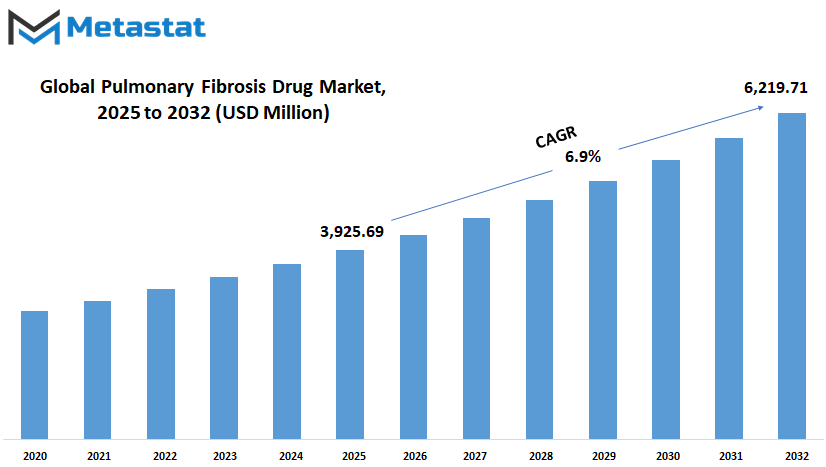
GROWTH FACTORS
The global pulmonary fibrosis drug market is set to see drastic transformation in the coming years. With more individuals aging, particularly in societies where aging demographics are high, there has been a visible increase in idiopathic pulmonary fibrosis (IPF) cases. A disease that targets the lungs and makes breathing more difficult for individuals tends to need extensive treatment and care over the long term. With this heightened demand, more attention is being placed on drug improvement that is used to treat it. It is one of the main reasons for this focus because there is ongoing improvement in drug research and development and the creation of new anti-fibrotic drugs that are more targeted in their action than previously. All these developments will help in building more treatment options for patients and in the long term can lead to better outcomes.
Despite these encouraging signs, other issues cannot be ignored. The biggest challenge remains the astronomically high cost of available treatments. To a great extent, these drugs are unaffordable to many patients, especially those who reside in poverty-stricken communities. This has the effect of delaying treatment or patients dropping it altogether, thus making them sicker with time. The second problem is the side effects that accrue from some of the available drugs. Even if a drug is effective, if it is too uncomfortable, then patients will drop it. Apart from that, the therapeutic scope of most of the existing drugs is low, and therefore some patients do not have many real options. All these problems create hurdles that limit the optimal potential of the market.
There is hope despite all this. A number of clinical trials are underway currently, evaluating some new drugs that can potentially change the face of treatment of IPF. Many of these drugs are being engineered so that they will have fewer side effects and be more potent in other patient populations. As these drugs proceed through the trial process, the promise is that they will bring real breakthroughs. Should they succeed, they will not only improve the lives of IPF patients but will also shake up the market. In the long run, these innovations will find wider access, better pricing, and better treatment. The global pulmonary fibrosis drug market has reached a stage where new findings can make a difference, ushering the way to a future with more hope and less suffering for patients.
MARKET SEGMENTATION
By Indication Type
The global pulmonary fibrosis drug market will grow gradually as pulmonary disease becomes increasingly well understood and medical science keeps on progressing. With the passage of time, more and more individuals are being diagnosed with pulmonary fibrosis of different types, and so the demand for effective treatment strategies is growing. This market is influenced by continuous efforts in healthcare not just to treat disease symptoms but also slow the rate of disease progression. With more and more types of treatments being tested and getting approval, the future of this market will be bright.
Another of the prime drivers of this market is that pulmonary fibrosis affects individuals differently depending on the type they have. The pharmacological market is shaped by the various presentations of the disease, such as Idiopathic Pulmonary Fibrosis (IPF), Non-Specific Interstitial Pneumonia (NSIP), Cryptogenic Organizing Pneumonia (COP), among others. IPF, for instance, has gained considerable attention due to the severity and unpredictability of the condition. Though the etiology of IPF remains unclear, research has led to medications that can reduce lung damage over time. In the future, this region is likely to be a center of interest as further breakthroughs are made.
NSIP and COP, though less frequent, need also to be included. NSIP is typically linked with autoimmune illnesses, while COP is typically linked with inflammation that in certain instances may react to therapy accordingly. The market for drugs that attack these specific diseases will expand, especially as better diagnostic devices make it easier to sort them out. Other types of pulmonary fibrosis may not be strictly in one category, but they must still be addressed and monitored, and this is more room for research and development.
In the future, this market will likely benefit from a greater understanding of genetic and environmental factors in pulmonary fibrosis. Personalized medicine may play an even more important part, with treatments chosen based on a patient's own condition and past history. Improved technology may deliver better and more directed drugs, which would improve life quality for many patients. global pulmonary fibrosis drug market is not merely about healing an illness but also about giving hope to patients who are faced with the challenges of enduring it.
By Drug Class
The global pulmonary fibrosis drug market will increase more as more focus is given to rare lung conditions that affect breathing and total lung capacity. Pulmonary fibrosis, which scarring of the lungs causes, does not allow oxygen to pass into the bloodstream. Over time, this disease narrows one's ability to live comfortably, and soon it affects everyday life in a major way. With enhanced diagnostic methods and heightened awareness, more and more people are coming to be diagnosed with this disease, and thus arises an ever-increasing need for beneficial therapies.
As science is progressing, newer families of drugs will play an instrumental role in managing this disease. Antifibrotic drugs will be the most dependable option for slowing down the disease process. Such drugs aim at prevention of scarring in lung tissues and allowing patients to have more time with better respiratory function. Corticosteroids, which have been the go-to drugs for curing inflammation for several decades, may still find a place in the therapy in certain situations. But doctors and researchers will continue to weigh their benefits against possible side effects. Immunosuppressive drugs are also being contemplated because they may offer added relief by calming the body's immune system, which sometimes causes lung damage.
Tyrosine kinase inhibitors are also a subject of new interest. They work by blocking certain signals that lead to unwanted cell migration, something that may have the potential to slow down the progression of lung scarring. These are still being tested in many trials but look promising in their outcomes. Other types of drugs, which are not in these broad categories, are also being investigated and might become even more helpful as knowledge grows. These might be supportive care drugs that reduce symptoms and improve quality of life.
In the years ahead, development will likely shift toward making treatment safer and more targeted. Personalized medicine, where medicines are prescribed according to the genetic makeup of the patient and the course of the disease, will decide the destiny of drug prescribing in the days to come. This will improve outcomes and reduce unnecessary side effects. Greater funding and coordination among investigators, health care practitioners, and drug companies will bring in newer treatments that are effective and cost-friendly. The global pulmonary fibrosis drug market will not only grow in size but also in kind and precision of the treatments it offers, promising hope to those suffering and building a future where this disease can be treated with greater confidence.
By Route of Administration
The global pulmonary fibrosis drug market is likely to undergo gradual changes in the next few years. Pulmonary fibrosis is a medical condition where the lung tissue is hardened and thickened, and hence, it is hard for patients to breathe. As more information becomes available about this condition, more emphasis will be placed on developing improved treatment processes. As medical research continues to advance, the drug companies will try to offer safer and more effective drugs. The patient will find drugs that not only treat the symptoms but also slow the progression of the disease.
One of the most important factors that will characterize the global pulmonary fibrosis drug market will be the way in which the drugs are administered to the patient. Based on the route of administration, the market further divides into oral, injectable, and inhalation modes. Each mode has its pros and cons. Oral medications are most often employed as they are easy to administer and do not require medical aid. They may not be as fast-working as any other method, however. Injected medication can be used when quicker effects are needed, especially if the disease is advancing rapidly.".
Inhalation as a method allows for direct lung delivery, which could be more advantageous for certain patients. In the future, therapies can combine these methods to maximize outcomes and restrict side effects.
With new technology coming into the medical arena, creating and testing these drugs will also change. Scientists can utilize advanced tools to discover more about how the disease targets the body. This will allow them to create drugs that target the problem more specifically. Because there is more understanding of the disease, there is a hope that treatments will become more customized, focusing on what is most helpful to each patient without using one method for everyone.
The health organizations and governments will also play a greater role. Funding can be increased for drug approval processes and research. This will help ensure that treatments are brought to patients faster than ever. While this is happening, companies would need to be watchful with prices and safety. With more demand for pulmonary fibrosis drugs, the global pulmonary fibrosis drug market will need to balance innovation with availability. In the coming days, this sector will not only be involved in the production of medicine but also in improving the lives of the individuals that it is dependent on.
By End-User
The global pulmonary fibrosis drug market is anticipated to develop steadily as medical technology progresses and new drugs emerge. Pulmonary fibrosis is a chronic disease that occurs in the lungs, forming scar tissue and making breathing a challenge for patients. As knowledge of this disease grows, so does demand for drugs that can control symptoms or retard disease progression. The demand for these drugs will be pulled from some of the environments where the patients are being treated, and understanding these environments is relevant when looking at how the market will change.
Hospitals will continue to be a significant part of the global pulmonary fibrosis drug market. It is where the majority of patients with severe or advanced cases of pulmonary fibrosis receive treatment. Hospitals have the experts and resources to deliver complex care, such as new medication when it comes out. With further advances in research, hospitals will receive more patients for new and better drugs, hence encouraging growth in this part of the market. Having qualified health professionals means that hospitals will remain an important channel of distribution for pulmonary fibrosis medication.
Clinics will also play an essential role in the global pulmonary fibrosis drug market. Clinics tend to treat patients in the initial stages of the disease or patients who require monitoring on a regular basis and continuous treatment. Healthcare centers are more accessible than hospitals and can offer personal attention to patients. As more medications for pulmonary fibrosis are simplified to be taken and monitored, clinics will become an attractive site where many patients will be able to receive their medication. It will increase the market by allowing access to an even wider group of people who need to be on continuous therapy but are able to take it outside the hospital.
Homecare sites will have an increasingly important position in the global pulmonary fibrosis drug market, especially with the ongoing progression of technology and medical care. The industry would prefer to treat the majority of their patients at home for convenience and independence. Having drugs available that do not require repetitive hospital stays will encourage this trend. Homecare in the future will likely grow as an inexpensive and easy solution for patients and caregivers alike. It will also allow pharmaceutical companies to manufacture products with ease in mind, pushing the market even further.
Research centers will be the foundation of the future of the global pulmonary fibrosis drug market. These are where new drugs are discovered and tested before patients receive them. Increased research investment will drive innovation and create better treatments. As more is learned about pulmonary fibrosis, the research laboratories will enable the release of new treatments that will transform how the disease is treated. What is created in these labs will determine the future of the market and give hope to patients around the globe.
Together, the global pulmonary fibrosis drug market will grow as a result of collaboration between research laboratories, homecare centers, clinics, and hospitals. All end-users will contribute towards improved patient care but in different ways such that the treatments become more effective and accessible with time. All this collaboration between different healthcare facilities will be in the limelight when it comes to how the market grows and meets pulmonary fibrosis patients' needs.
|
Forecast Period |
2025-2032 |
|
Market Size in 2025 |
$3,925.69 million |
|
Market Size by 2032 |
$6,219.71 Million |
|
Growth Rate from 2025 to 2032 |
6.9% |
|
Base Year |
2024 |
|
Regions Covered |
North America, Europe, Asia-Pacific, South America, Middle East & Africa |
REGIONAL ANALYSIS
The global pulmonary fibrosis drug market will expand significantly over the next few years, driven by what occurs in different parts of the globe. The expansion will not only be based on advances in medical science but also on the manner in which different regions embrace and disseminate new treatments. The market is divided geographically into several significant areas, each characterized by its own traits and potential for growth.
North America will continue to be important, with the United States leading the way in terms of drug innovation and patient care. The sophisticated research facilities and mature healthcare infrastructure will facilitate new therapies onto the market at an accelerating pace. Canada and Mexico will have their own contributions, although smaller ones, in bringing more access to these treatments and in conducting clinical trials that can improve patient outcomes. The focus of the region on increasing early diagnosis and personalized treatment will also propel the market further.
Europe will also contribute to the global pulmonary fibrosis drug market. The UK, Germany, France, and Italy will benefit through collaborative efforts in healthcare research and government subsidies for chronic disease management. This collaboration is likely to introduce cost-effective and accessible drugs across the continent. Additionally, the smaller countries within the Rest of Europe will also gradually increase their contribution, further improving general market coverage and allowing more patients to gain access to newer treatments.
Asia-Pacific will witness rapid growth due to high population and increasing awareness of pulmonary fibrosis. China, India, Japan, and South Korea will invest heavily in healthcare facilities and pharma research. Its expanding middle class and improving healthcare policy will make it easier for patients to gain access to new treatments, which will drive the market growth. Rest of Asia-Pacific will follow the same trend, expanding access to therapy across more remote or underserved geographies.
South America will continue to develop gradually with Brazil and Argentina leading healthcare system development and support for clinical research. The countries will seek greater public education and campaigns of higher quality care for pulmonary fibrosis patients. The Rest of South America will gradually catch up, causing market growth across the continent.
The Middle East and Africa will exhibit healthy growth, and specifically in the GCC nations, Egypt, and South Africa. Investment in healthcare infrastructure and tie-ups with global pharma companies will enable introduction of highly sophisticated pulmonary fibrosis medicines in these markets. Although challenges are present, such as limited healthcare coverage in some areas, sustained efforts will increase treatment availability and enhance patient care.
In the years to come, the global pulmonary fibrosis drug market will be sustained by continuous innovation, greater access, and increased international collaboration. All these will assist in providing better treatment and a better quality of life for patients worldwide.
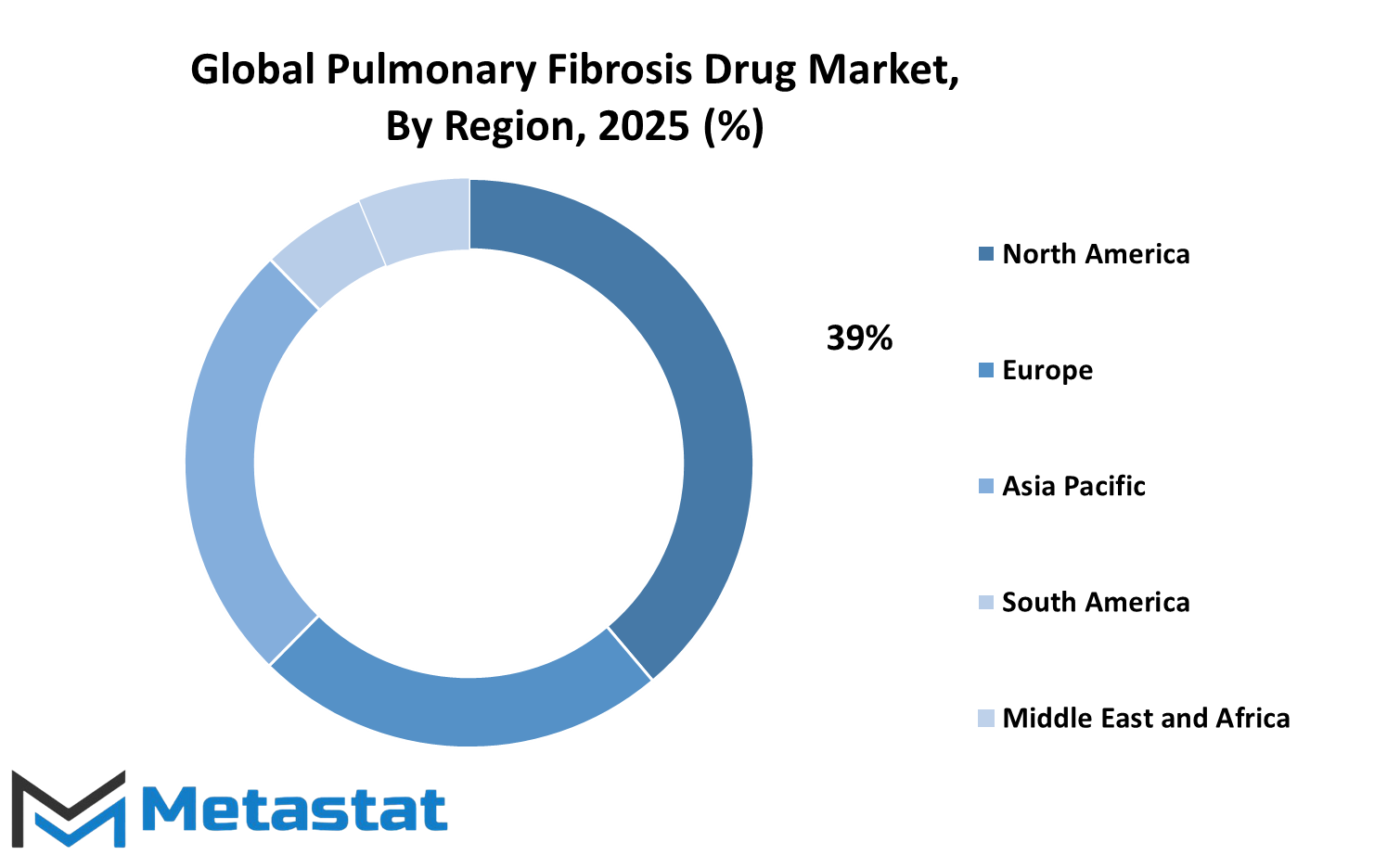
COMPETITIVE PLAYERS
The global pulmonary fibrosis drug market is poised to see radical changes as it moves along, led by the advancement of medical research and improving understanding of this debilitating disease. Pulmonary fibrosis is a disease that affects lungs by developing scarring and thickening of lung tissue, which prevents individuals from being able to breathe. Since this disease is so multifaceted, a constant search for treatments that can reverse or halt the lung damage has been ongoing. This search has created the pharmaceutical market targeting pulmonary fibrosis a thriving and lucrative market.
Some of the leading companies are important to the development and provision of new treatments for pulmonary fibrosis. These are the key players that are being headed by top pharma giants such as AbbVie Inc., AstraZeneca, Bayer AG, and Boehringer Ingelheim. They have other players such as Bristol-Myers Squibb, Eli Lilly and Co., FibroGen, Inc., and Galapagos NV, who have been investing massively in research to find viable solutions. Companies such as Genentech, Inc., Gilead Sciences, Inc., Medtronic, Novartis International AG, Melius Pharma AB, Pfizer Inc., and Roche Holding AG also contribute significantly by bringing new medicines and technologies to the market. These companies collectively are making strides that could help improve the quality of life for many patients.
In the coming years, the future of the global pulmonary fibrosis drug market will be shaped by emerging technology and individualized medicine. With enhanced diagnostic technology, treatments can be formulated to meet the specific needs of patients, thereby being more efficient. In addition, the use of digital health tools will facilitate better monitoring and management of the disease, allowing doctors to modulate treatments in real-time. These changes will allow treatment to be extended and made more efficient, potentially extending lives and reducing the load on the planet's healthcare systems.
As the studies continue, new drugs will be found, with the help of collaboration among the top firms in the sector. They will collaborate with medical professionals and researchers to understand the disease better and design drugs to target the cause of pulmonary fibrosis. In collaboration, a better future can be envisioned, with greater options for patients and better care during the treatment.
In all, the global pulmonary fibrosis drug market will expand with the innovations that hold out hope for the victims of this disease. The dedication of key players and advancements in science will offer scope for improving treatments, doing their share towards managing pulmonary fibrosis in the future.
Pulmonary Fibrosis Drug Market Key Segments:
By Indication Type
- Idiopathic Pulmonary Fibrosis (IPF)
- Non-Specific Interstitial Pneumonia (NSIP)
- Cryptogenic Organizing Pneumonia (COP)
- Others
By Drug Class
- Antifibrotic Agents
- Corticosteroids
- Immunosuppressive Drugs
- Tyrosine Kinase Inhibitors
- Others
By Route of Administration
- Oral
- Injectable
- Inhalation
By End-User
- Hospitals
- Clinics
- Homecare Settings
- Research Laboratories
Key Global Pulmonary Fibrosis Drug Industry Players
- AbbVie Inc.
- AstraZeneca
- Bayer AG
- Boehringer Ingelheim
- Bristol-Myers Squibb
- Eli Lilly and Co.
- FibroGen, Inc.
- Galapagos NV
- Genentech, Inc.
- Gilead Sciences, Inc.
- Medtronic
- Novartis International AG
- Melius Pharma AB
- Pfizer Inc.
- Roche Holding AG
WHAT REPORT PROVIDES
- Full in-depth analysis of the parent Industry
- Important changes in market and its dynamics
- Segmentation details of the market
- Former, on-going, and projected market analysis in terms of volume and value
- Assessment of niche industry developments
- Market share analysis
- Key strategies of major players
- Emerging segments and regional growth potential



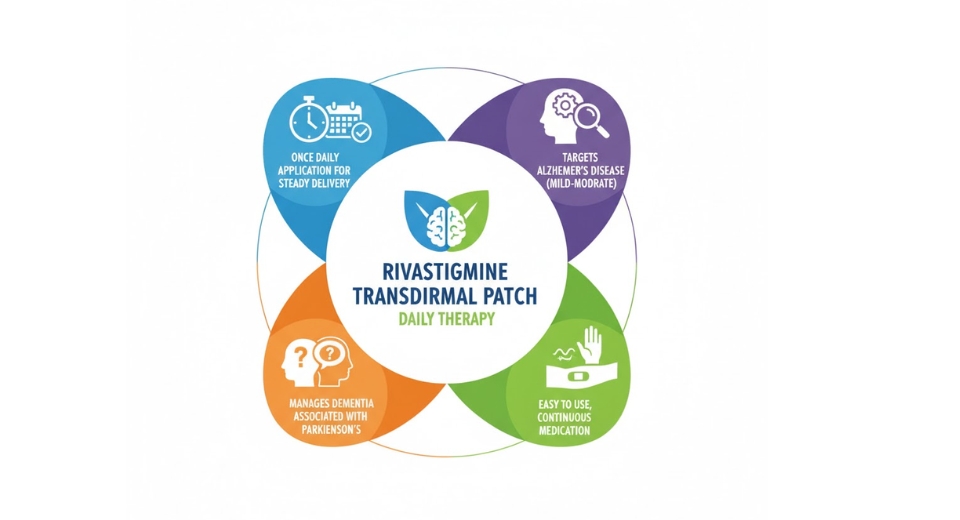
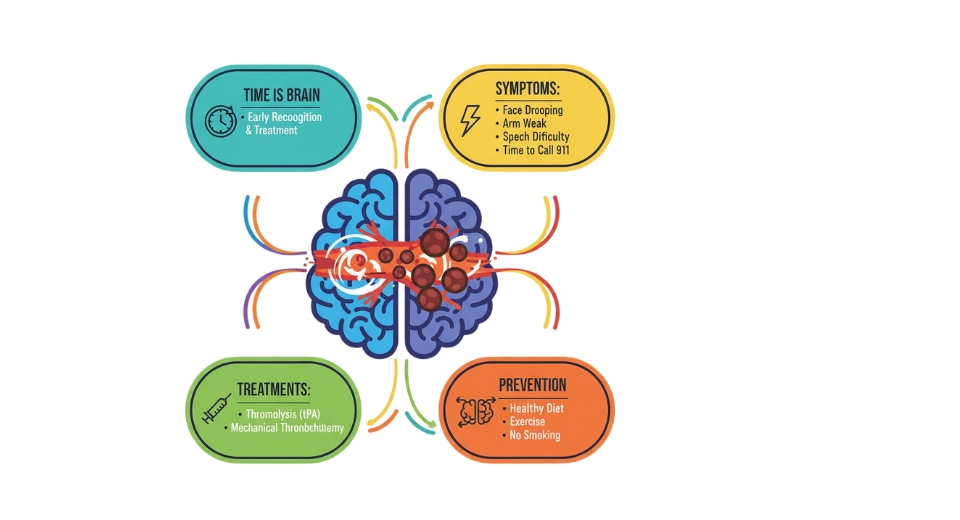
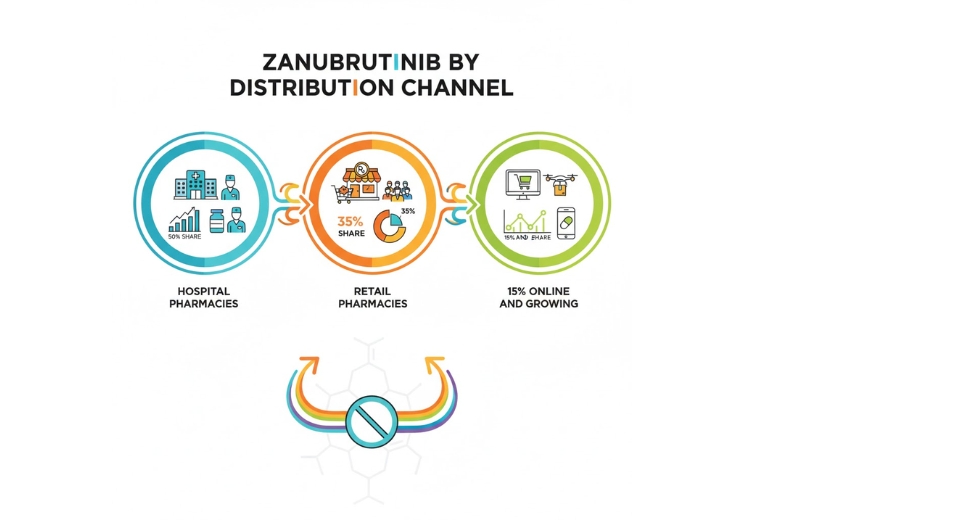
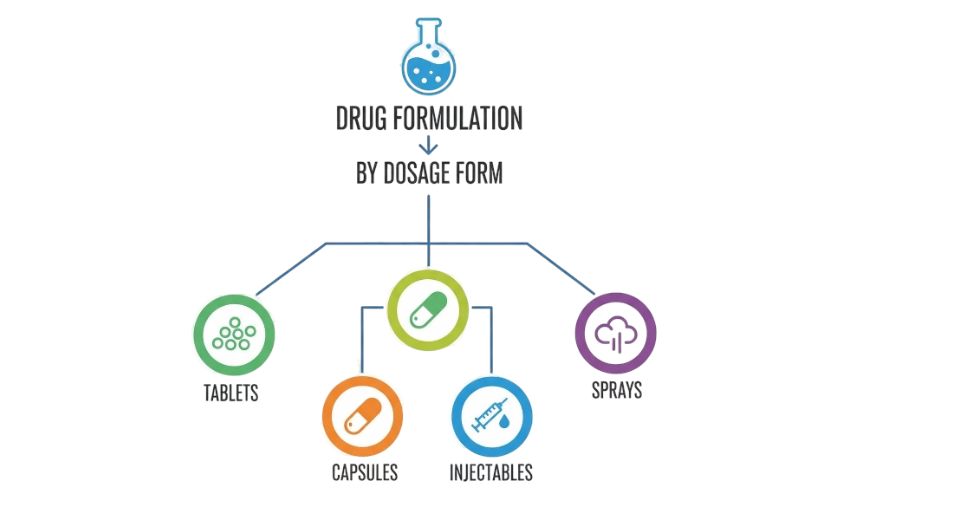

 US: +1 3023308252
US: +1 3023308252






